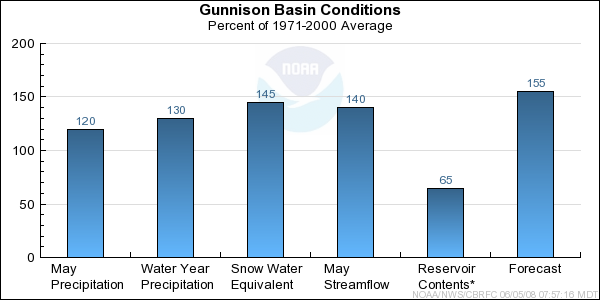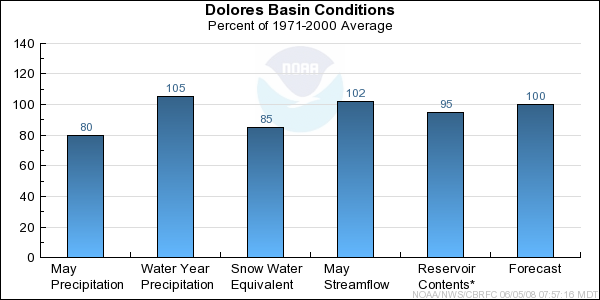Upper Colorado Water Supply Outlook, June 1, 2008
Note: This publication is scheduled for revision. If you have feedback on content, format, or publication frequency, please contact us.
Contents
Upper Colorado Summary
The Upper Colorado mainstem and the Gunnison basin both received above average precipitation for the month, but the Dolores basin only received 80% of average. Temperatures averaged over the entire month were near to slightly below average in western Colorado during May, but daily temperatures within the month fluctuated between periods of much above and much below average temperatures. As a result, May runoff volumes were much above average in the Upper Colorado and Gunnison, but there is plenty of snow left to melt as June 1st snow water equivalent is much above average. May runoff volumes in the Dolores basin were near normal and June 1st snow water equivalent is below average. The median of the forecasts for the April through July runoff volumes increased in the Upper Colorado and Gunnison, but decreased in the Dolores.

*Median of forecasts within each basin.
Upper Colorado Mainstem Basin Conditions
After two months of slightly below average precipitation, the Upper Colorado mainstem basin returned to wetter conditions during May with 110% of average precipitation for the month. This, combined with already high snowpack and near to slightly below average monthly temperatures, left the June 1st snow water equivalent values at much above average. The April through July streamflow forecasts were raised at most points in the basin, although some did go down because of low observed flows to date. These forecasts now range between 98% and 145% of average, with the exception of Mill Creek which is forecast at 66% of average.

* Percent usable capacity, not percent average contents.
Click for multi-month Graph.
Gunnison Basin Conditions
Precipitation was above average in the month of May for the Gunnison Basin. Maximum temperatures were again below average resulting in a slower melting of the snow pack. However, runoff volumes in the Gunnison Basin were above average for May because of the above average snow pack.
April through July volume forecasts in the Taylor Basin and Blue Mesa Reservoir have been been increased due to the above average precipitation in May. April through July volume forecasts in the rest of the basin remained steady.

* Percent usable capacity, not percent average contents.
Click for multi-month Graph.
Dolores Basin Conditions
The Dolores Basin did not fair as well as the rest of the Upper Colorado only receiving 80% of the average May precipitation. However, maximum temperatures were below average in May like the rest of the Upper Colorado. Runoff volume in the basin was around average for May.
There is little snow remaining in the Dolores Basin. This, along with below average precipitation for May, has resulted in a 5% to 10% decrease in the April through July volume forecasts in the Dolores Basin.

* Percent usable capacity, not percent average contents.
Click for multi-month Graph.
Differences between the full period forecasts and the residual forecasts may not exactly equal the actual observed volumes due to rounding conventions (see Definitions section).
Precipitation Maps


Hydrologist: Brenda Alcorn, John Lhotak







